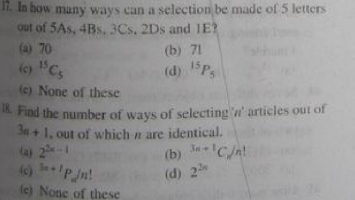My friend told me Lets divide into two : identical and non identical group in to
n and 2n +1 articles respectively .
Identical n articles | Non identical 2n+1 articles
selection:
0 | 2n+1 c N
1 | 2n+1 c n-1
2 | 2n+1 C n-2
.. .
...
n | 2n+1 C 0
Each different event : adding up : 2n +1 c N + 2n +1 c n-1 + ......+ 2n+1 C 0
THen what ?
First, I'll tell you that I haven't even tried to fully solve this yet myself, because I'm here just to help you think, and don't want to have a solution in mind to short-circuit that process. But I have tried thinking along with you, and there are a couple things I would do if I were you. (In fact, I've just now done these bits.)
One is this: we've manually counted the answers for a couple small cases, so you can see whether any of the choices you are given yield those numbers. I normally despise multiple-choice problems, because they allow you to solve them without doing the real work; but one reason I ask for the choices is that they can help us determine whether our interpretation is right, and they can also give us a sense of how complicated an answer we can expect. In this case, with "none of these" as an option, we can't be sure, but it can still help a little. In any case, we already know which answer it has to be, unless they are being tricky and that answer only works for the first two cases!
Another is, now that you have a proposed general solution, though it is not simple enough to check against the choices, we can check it against our answers! Does your summation give 4 for n=1 and 16 for n=2?
At this point, we've been encouraged that the summation looks like it is correct, and should be able to be simplified; so we have two choices: We can work algebraically (or otherwise) to simplify it, or we can look for a different approach that won't lead to a summation (perhaps using the apparent answer as a clue to what sort of approach might lead to that sort of answer!). Or we could suppose that the apparent answer (suggested not only by the choices but also by our small cases) is correct, and use mathematical induction to prove that the summation is equal to that, if you know that method. (It's a method that is used to prove formulas but can't be used to derive them.)
So, do what I've suggested (checking the choices and checking your summation), and then decide what to do next! (I'll probably be doing that now. I have several methods in mind.)

